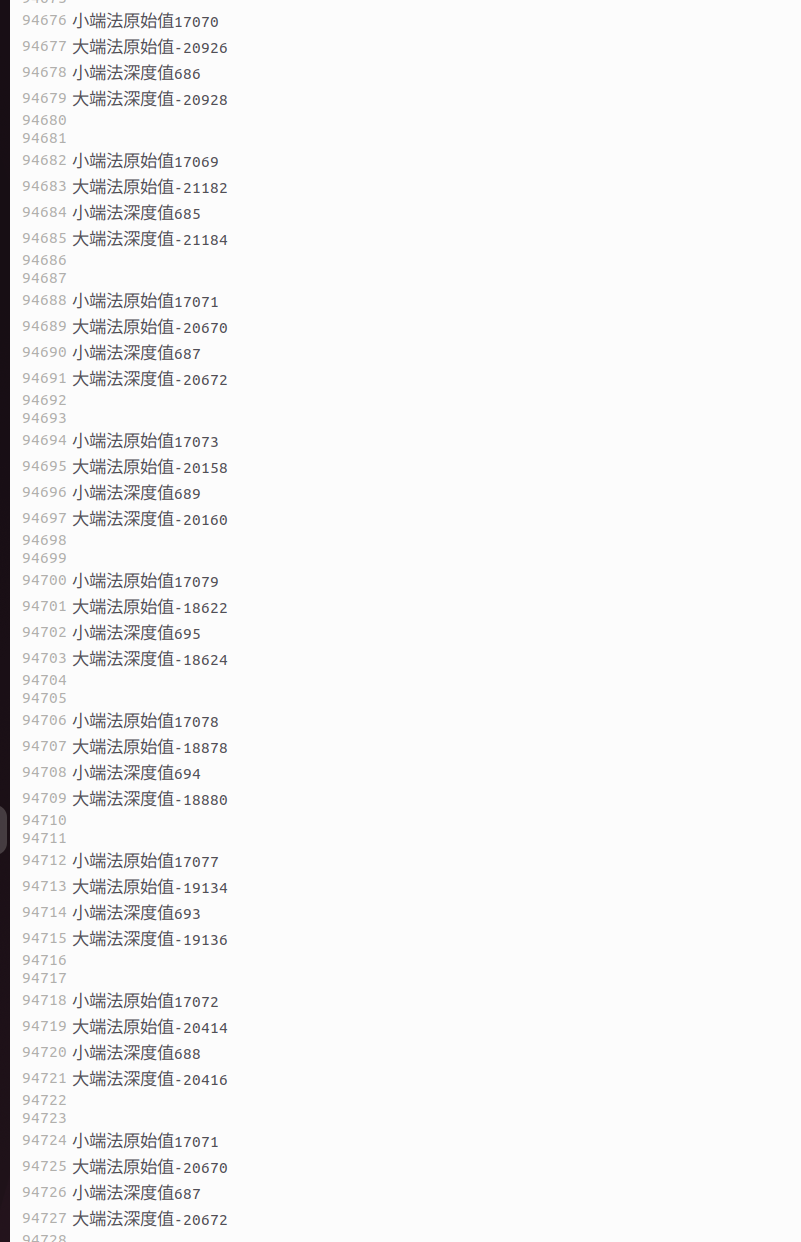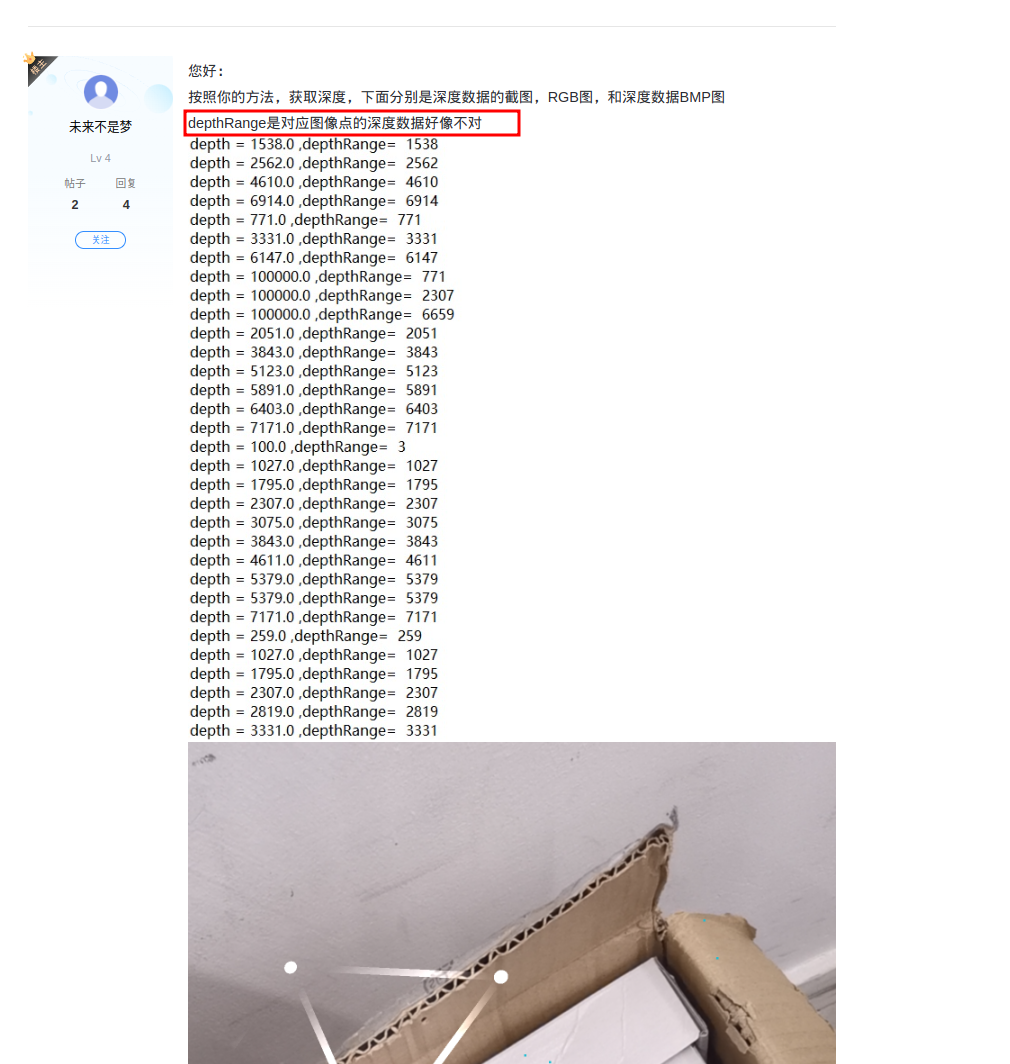保存深度值——小端序,位数,Android,Huawei AR engine
保存深度值——小端序,位数,Android
accuireDepthImage
华为Mate Pro系列基本上前置摄像头都是有TOF的,也就是能够得到场景的深度信息,在华为的AR engine里提供了一个方法可以读取场景的深度值。

不过其官方文档里对这个方法的介绍很少,寥寥数语,前期也在这里踩了一些坑。Google的AR core对这个深度值做了详细的介绍:
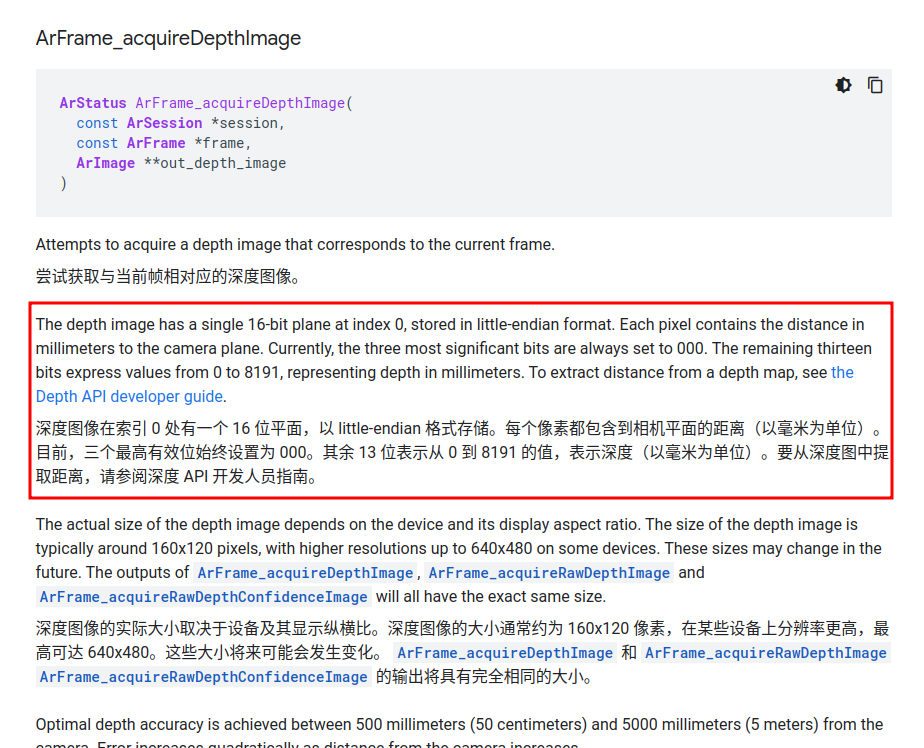
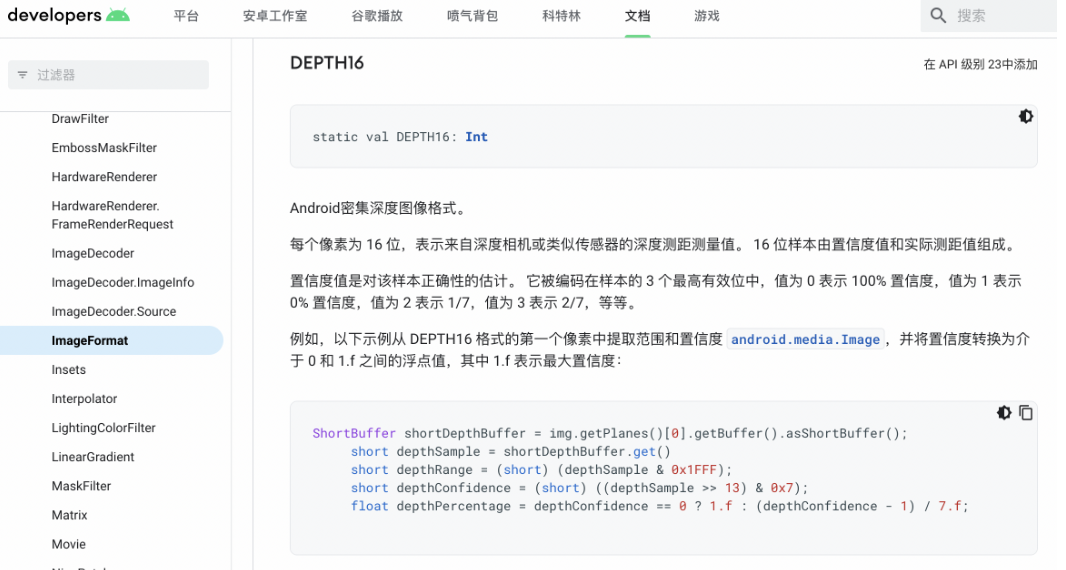
得到的深度图是16位的,其中高3位是置信度,低13位是采样得到的深度值,并且排列顺序是小端序。第一张图说设高3位为0,但是我看了一下,其实是第二种情况。
知道这个信息之后,我们便可以使用如下代码保存深度值(二进制文件):
Image depthImage = arFrame.acquireDepthImage();
File f = new File(dir, numFrameStr + "_depth16.bin");
if(depthImage.getFormat() != ImageFormat.DEPTH16)
throw new RuntimeException("Expected image format is DEPTH16, but is:"+depthImage.getFormat());
ByteBuffer buffer = depthImage.getPlanes()[0].getBuffer();
try {
FileChannel fc = new FileOutputStream(f).getChannel();
fc.write(buffer);
fc.close();
} catch (IOException e) {
e.printStackTrace();
Log.i(TAG, "Error writing image depth16: " +f.getPath());
}
将二进制文件打开看一下:
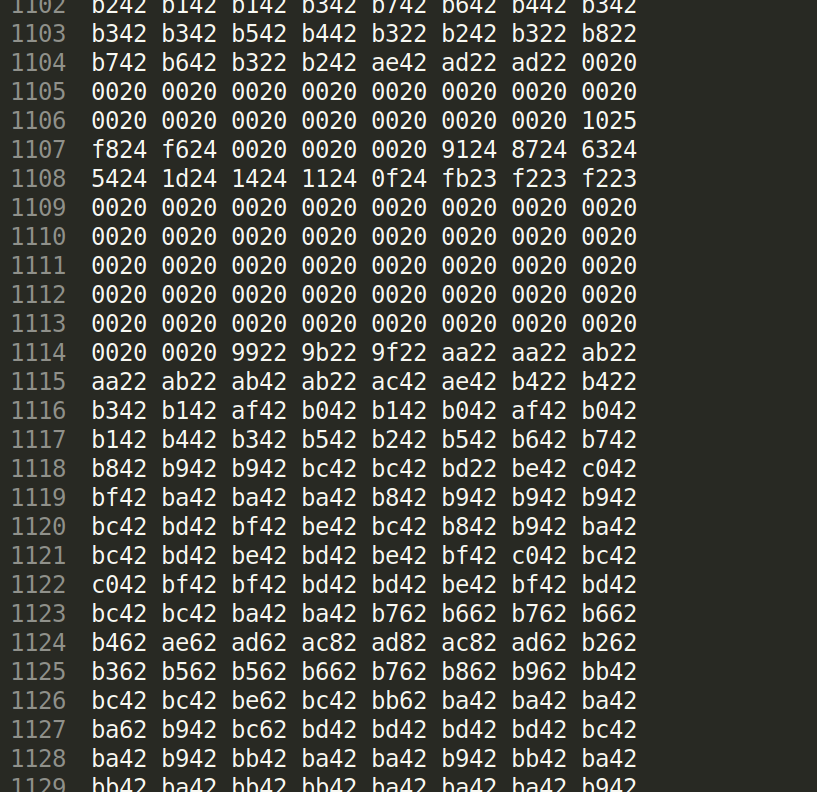
文件是以16进制保存的,所以每四个数字代表一个深度值。取0x0020,0x2242转化为十进制的深度值看一下。
| 16进制 | 0x0020 | 0x2242 | 0xba42 |
| 二进制 | 0000 0000 0010 0000 | 0010 0010 0100 0010 | 1011 1010 0100 0010 |
| 由于是小端序,将高位字节拿到前面 | 0010 0000 0000 0000 | 0100 0010 0010 0010 | 0100 0010 1011 1010 |
| 将高三位的置信度设为0 | 0000 0000 0000 0000 | 0000 0010 0010 0010 | 0000 0010 1011 1010 |
| 十进制 | 0mm | 546mm | 698mm |
最后我们将这个二进制文件转化为格式为CU_16的灰度图看一下:

效果还不错。
depthImag保存为图像
前面的保存的二进制文件是保存了置信度信息的,如果想要保存深度图就需要把高3位置信度信息设为0,才能保存。代码如下:
Image depthImg = arFrame.acquireDepthImage();
int width = depthImg.getWidth();
int height = depthImg.getHeight();
//ShortBuffer shortBuffer = depthImg.getPlanes()[0].getBuffer().asShortBuffer();
ShortBuffer shortBuffer = depthImg.getPlanes()[0].getBuffer().order(ByteOrder.LITTLE_ENDIAN).asShortBuffer();
Bitmap disBitmap = Bitmap.createBitmap(width, height, Bitmap.Config.ARGB_8888);
for (int i = 0; i < height; i++) {
for (int j = 0; j < width; j++) {
int index = (i * width + j);
shortBuffer.position(index);
short depthSample = shortBuffer.get();
// 获取深度值后13位
short depthRange = (short) (depthSample & 0x1FFF);
// 拆分short数据成两个8位数据
int highByte = (depthRange & 0xFF00) >> 8; // 获取高8位
int lowByte = depthRange & 0x00FF; // 获取低8位
disBitmap.setPixel(j, i, Color.argb(255 , highByte, lowByte, 0));
}
}
try {
FileOutputStream out = new FileOutputStream(file);
disBitmap.compress(Bitmap.CompressFormat.PNG, 100, out);
out.flush();
out.close();
//GLES20.glClear(GLES20.GL_DEPTH_BUFFER_BIT);
} catch (Exception e) {
e.printStackTrace();
}
恢复深度值的时候就可以读出R通道的值,然后左移八位(乘256),再加上G通道的值。
注意这里有一个非常隐晦的BUG,就是如果使用的是第5行被注释的代码保存ShortBuffer,得到的将是大端序的值,现在一般的机器都是小端序列,如果使用大端序这将会导致一些错误。
可以看到小端法使用的是
ShortBuffer shortBuffer = depthImg.getPlanes()[0].getBuffer().order(ByteOrder.LITTLE_ENDIAN).asShortBuffer();:其值是准确的,而使用
ShortBuffer shortBuffer = depthImg.getPlanes()[0].getBuffer().asShortBuffer();得到了错误的结果。
有些遗憾的是,我发现论坛里HMS 小助手提供的代码是有问题的:
这里应该使用
ShortBuffer shortDepthBuffer = plane.getBuffer().order(ByteOrder.LITTLE_ENDIAN).asShortBuffer();论坛里这个朋友也遇到了类似的问题:
最后建议在java中配置一下opencv直接保存为16位灰度图(推荐):
public static void writeDepth16binInPng16GrayscaleTum(String bin, int width, int height, String png) throws IOException {
byte[] bytes = Files.readAllBytes(Paths.get(bin));
ByteBuffer buffer = ByteBuffer.wrap(bytes);
buffer = buffer.order(ByteOrder.LITTLE_ENDIAN);
ShortBuffer sBuffer = buffer.asShortBuffer();
short[] depthTum = new short[width*height];
Mat mat = Mat.eye(height, width, CvType.CV_16UC1); //max is 65536 == 65meters / 16 bits = 2 bytes
int i=0;
for (int h = 0; h < height; h++) {
for (int w = 0; w < width; w++) {
short depthSample = sBuffer.get(); //depth16[y*width + x];
short depthMm = (short) (depthSample & 0x1FFF);
// short depthConfidence = (short) ((depthSample >> 13) & 0x7);
depthTum[h*width+w] = (short)(depthMm * 5); //tum rgbd is 5==1mm / 5000==1m
}
}
mat.put(0, 0, depthTum);
Imgcodecs.imwrite(png, mat);
//buffer.clear();
}
最后感谢remmel的精彩工作,提供了非常优秀的参考!
code
read_bin.cpp
//
// Created by xin on 23-11-15.
//
#include <iostream>
#include <opencv2/opencv.hpp>
#include <fstream>
#include <vector>
int main() {
// 文件路径
std::string file_path = "/home/xin/Code/CLionProjects/depth_image/img/another/0_depth16.bin";
std::ifstream file(file_path, std::ios::binary);
if (!file.is_open()) {
std::cerr << "Failed to open the file." << std::endl;
return 1;
}
// 读取文件内容到 vector
std::vector<uint16_t> depth_values;
uint16_t value;
while (file.read(reinterpret_cast<char*>(&value), sizeof(value))) {
value = value & uint16_t(0x1FFF); // 这个是真实的深度值
value *= 5; // 为了更好的可视化,使得灰度图更亮一些
depth_values.push_back(value);
}
file.close();
cv::Mat depth_image(180, 240, CV_16UC1);
// 将 depth_values 复制到 depth_image 中
std::memcpy(depth_image.data, depth_values.data(), depth_values.size() * sizeof(uint16_t));
cv::imwrite("DepthImage.png", depth_image);
cv::waitKey(0);
return 0;
}
保存深度值——小端序,位数,Android,Huawei AR engine的更多相关文章
- 《Intel汇编第5版》 Intel CPU小端序
一.MASM汇编器中的数据类型 二.Intel汇编中的立即数类型 三.定义有符号和无符号整数 四.小端序 内存中数据按照字节存储,一个4个字节无符号整数,其高位存储在低地址上,低位存储在高地址上. 比 ...
- java音视频编解码问题:16/24/32位位音频byte[]转换为小端序short[],int[],以byte[]转short[]为例
前言:Java默认采用大端序存储方式,实际编码的音频数据是小端序,如果处理单8bit的音频当然不需要做转换,但是如果是16bit或者以上的就需要处理成小端序字节顺序. 注:大.小端序指的是字节的存储顺 ...
- C# 中大端序与小端序
C# 中大端序与小端序 static void Main(string[] args) { uint value = 0x12345678; Console.WriteLine("原始字节序 ...
- c++——大端序,小端序的排列问题
#include<iostream> using namespace std; union TestModel { int i; char ch; }; int main() { unio ...
- C/C++字节序(大端/小端)判断
C/C++大端小端判断 说的是变量的高字节.低字节在内存地址中的排放顺序. 变量的高字节放到内存的低地址中(变量的低字节放到内存的高地址中)==>大端 变量的高字节放到内存的高地址中(变量的低字 ...
- 大端模式 VS 小端模式
简单点说,就是字节的存储顺序,如果数据都是单字节的,那怎么存储无所谓了,但是对于多字节数据,比如int,double等,就要考虑存储的顺序了.注意字节序是硬件层面的东西,对于软件来说通常是透明的.再说 ...
- 大端小端转换,le32_to_cpu 和cpu_to_le32
字节序 http://oss.org.cn/kernel-book/ldd3/ch11s04.html 小心不要假设字节序. PC 存储多字节值是低字节为先(小端为先, 因此是小端), 一些高级的平台 ...
- 【C#基础概念】字节顺序(大端、小端)
字节顺序,又称端序或尾序(英語:Endianness),在计算机科学领域中,指電腦記憶體中或在数字通信链路中,组成多字节的字的字节的排列顺序. 例如假设上述变量x类型为int,位于地址0x100处,它 ...
- Android为TV端助力 同时setTag两次,保存多种值
示例代码: view.setTag(R.string.action_settings,hodler.content); 接收两个值,一个是key值,必须是唯一值,而且要写在values/ids.xml ...
- 用C语言,如何判断主机是 大端还是小端(字节序)
所谓大端就是指高位值在内存中放低位地址,所谓小端是指低位值在内存中放低位地址.比如 0x12345678 在大端机上是 12345678,在小端机上是 78564312,而一个主机是大端还是小端要看C ...
随机推荐
- 即时通讯技术文集(第19期):IM架构设计基础知识合集 [共13篇]
为了更好地分类阅读 52im.net 总计1000多篇精编文章,我将在每周三推送新的一期技术文集,本次是第19 期. [-1-] 微信后台基于时间序的新一代海量数据存储架构的设计实践 [链接] htt ...
- 【宝塔】搭建随机图API
创建站点 首先,我们打开服务器的宝塔面板,如果没安装的推荐安装一个,因为这个对建站小白来说非常的方便. 我们参加一个 API 站点 然后到站点设置里申请一个 ssl 认证,再打开强制 https 添加 ...
- .net core 3.x 发布单文件
.翻译自:https://github.com/dotnet/designs/blob/master/accepted/2020/single-file/staging.md NET Core 3.0 ...
- Python绘制土地利用和土地覆盖类型图详解
土地利用和土地覆盖是环境科学和城市规划中的重要概念,它们能够帮助本文理解人与自然的关系,促进可持续发展.随着城市化进程的加快,科学地监测和管理土地资源显得尤为重要.Python作为一种强大的编程语言, ...
- PHP 安装启用imagick(解决 word press可选的模组imagick未被安装或已被禁用)
本教程仅适用Windows Servier IIS网站服务器. 我的博客使用IIS搭建,相比Linux,相关的教程格外少.因此让以后的小伙伴也能马上解决问题,分享此方法. 首先需要下载php对应版本的 ...
- 【刷题】牛客模拟面试 > 模拟面试报告
https://www.nowcoder.com/interview/ai/index 1-TCP协议的流量控制和拥塞控制 TCP的流量控制是基于窗口机制实现的: 在建立连接时, 发送方和接收方都会建 ...
- 项目PMP之三项目经理
一.项目经理定义:由执行组织委派,领导实现目标 二.影响范围: 项目本身:相关方沟通.完善各职能结构:通过人际关系和沟通技能及积极态度充当沟通者,以平衡项目相关方并达成共识 组织:组织结构中进行积极沟 ...
- java重载-构造方法也存在重载-数据类型的提升
重载 1.一个类中不能声明多个相同的方法,属性. 2.上面的相同指的是方法名,参数列表相同.和返回值类型无关. 3.如果方法名相同,但是参数列表(个数,顺序,类型)不相同,会认为是不同的方法,在jav ...
- 五. Redis 配置内容(详细配置说明)
五. Redis 配置内容(详细配置说明) @ 目录 五. Redis 配置内容(详细配置说明) 1. Units 单位配置 2. INCLUDES (包含)配置 3. NETWORK (网络)配置 ...
- Matplotlab显示OpenCV读取到的图像
Matplotlab显示OpenCV读取到的图像 一. 确认图像的数组类型 在使用 OpenCV 的 cv2.imread() 函数读取图像时,第二个参数(标志)决定了图像的读取方式.具体来说,0.1 ...

